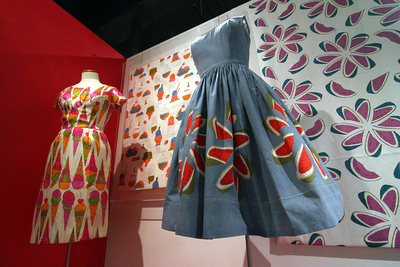Artist Textiles: Picasso to Warhol
by Frances J. Folsom
The American History Textile Museum in Lowell is the ideal setting for Artist Textiles: Picasso to Warhol (on view through March 29). The museum is housed in a 19th century building that was the Kitson Machine Shop, a textile mill that prepped cotton.
Why Lowell?
In 1821 Boston businessmen Nathan Appleton, Patrick Jackson and Amos and Abbott Lawrence founded the Merrimac Manufacturing Company building mills to produce textiles, warehouses for storing them and a railroad for shipping and receiving. They brought in engineers to build canals for harnessing the power of the Merrimac and Concord Rivers and Pawtucket Falls.
Their call for workers went out to the surrounding farmlands and as far away as Europe. Hundreds of workers, mostly immigrants, signed up to work in the mills. The Merrimac Manufacturing Company built houses, churches, schools, libraries and laid out parks along the rivers for the them. The mills ran 12 hours a day 6 days a week. The city of Lowell sprang to life as a manufacturing center for textiles. It would go on to play a leading role in the Industrial Revolution.
Art for the Masses
Artist Textiles; Picasso to Warhol features 200 textile designs detailing fauvism, cubism, surrealism, constructivism, abstraction and pop art. This is an opportunity to see the works of artists such as Pablo Picasso, Andy Warhol, Salvatore Dali, Raoul Dufy, Fernand Léger, Marc Chagall, Henri Matisse and Joan Miró on clothing designed by fabric manufacturers of the 1940s, ’50s, ’60s and ’70s. On loan from the Fashion and Textile Museum in London Artist Textiles: Picasso to Warhol tells a story of European and American art movements and bringing art to the masses.
After World War II, textile designer Zika Ascher went to France and met with artists Henri Matisse and Henry Moore where he convinced them to design headscarves. These small squares of silk or cotton would be a boost to the economy of haute couture and create work in textile mills. At the same time, the New York-based Wesley Simpson Custom Fabrics contracted surrealists artists Salvatore Dali and Marcel Vertex to also design headscarves.
In 1953, New York manufacturer Dan Fuller, owner of Fuller Fabrics, started his Modern Masters Series by asking Picasso, Miro, Dufy, Leger and Chagall to put their works on textiles. The artists would create the designs then turn the work over to graphic designers. This project set the standard for other textile manufacturing companies to produce affordable designs by famous artists.
The Exhibit
On the ground floor gallery, you can breeze past Raoul Dufy’s “Les Viola” a block-printed cotton furnishing textile by Bianchini-Férier, France c.1919, several works by Rockwell Kent and the displays by artists of the Bloomsbury Omega Workshops.
The “must sees” are Salvatore Dali’s screen-printed rayon crepe dress “Flower Ballet” dating to 1947; Dali’s “Number Please?” a silk headscarf with an assortment of colored telephone receivers on it; and Matisse’s blue and white screen-printed headscarf “Echarpe #1,” both are c. 1947.
Around the corner from these you will find “Fit for a Queen” three cotton summer dresses in reds, rusts and greens with flounce skirts nipped in at the waist. Artists Graham Sutherland and Alastair Morton designed these in 1946 for the British company, Horrockses Crewdson & Company, which became purveyors to the royal family. Queen Elizabeth and Princess Margaret purchased several dresses this style.
The Warhol dresses are center stage in this gallery. This is the first time they have been seen in public in America. Behind them are panels Warhol painted for Serendipity 3 Café in New York City. The “Ice Cream Sundae” dress is done in rows of ice cream cones in brilliant shades of pistachio, raspberry and orange on white silk. It’s partnered with “Melons” a sleeveless blue cotton dress decorated with huge slices of watermelons.
Joan Miró also excerpted from his original works in designing dresses for fabric companies. His pale green short-sleeved day dress, “Farmer’s Dinner,” is bedecked with white roosters mimicking one of his furnishing textiles.
The upstairs gallery holds “Picasso Unseen”—a collection of jackets and dresses that he put his designs on for White Stag and Bloomcraft Fabrics in the 1960s. The Bloomcraft dresses were featured in the December 1963 issue of Look magazine.
Holding their own against Picasso are the whimsical works of Saul Steinberg. For his beautiful border print “Paddington Station” c. 1952, Steinberg designed the London train station using rubber on cotton. His talent for detail shows in a 1950 screen-printed glazed cotton furnishing textile dubbed “The Wedding” where he has drawn the bride and groom and wedding guests adorned in 19th century finery. Shown with these is one of the dresses he created, “Arab Town,” a short sleeved shirtwaist in the colors of the desert, warm browns, teals and oranges.
Many of the artists charged the fabric companies just $1.50 to $2 per yard. These designs did what they were made to do; they brought art to Americans and Europeans at, in most cases, an affordable price.
Artist Textiles: Picasso to Warhol
November 21, 2014 – March 29, 2015
American Textile History Museum
491 Dutton St. #2, Lowell, MA 01854
978-441-0400
www.athm.org
________________________________________________________________________________________________
Image Credit: Images courtesy of the American Textile History Museum.
________________________________________________________________________________________________
Fran Folsom is a Cambridge based freelance journalist. When she is not traveling throughout New England and beyond she writes about art, history and travel.




